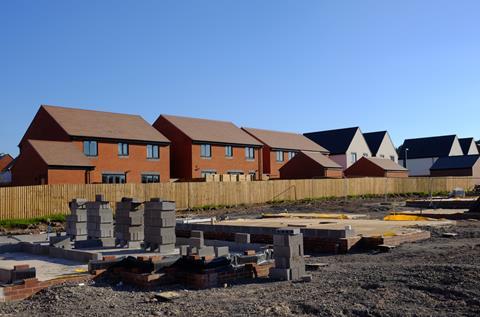Lichfields director suggests plan to cut targets will hinder industry’s ability to recover from imminent downturn

The planned abolition of housebuilding targets could see housing delivery drop to levels not seen since the aftermath of the global financial crisis, according to an analysis carried out by planning consultant Lichfields.
An article written by Lichfields’ senior director Matthew Spry estimates that the number of net additional homes delivered each year is likely to fall to “well below 160k, perhaps down to 140k”, given the effect of removing the pressure on councils to deliver permissions, without replacing it with another “hard” target of some kind.
This compares to net additional homes produced last year of 216,490 in England, already a drop on the 242,700 of the prior year, and would represent a fall of between 26-35%.

The last time that less than 160,000 net additions was produced in England was 2013/14, while the housebuilding sector was still recovering from the drop off in production seen during the global financial crisis.
Spry said his estimate was based on the assumption that after the removal of the targets, which PM Liz Truss has branded “Stalinist”, most local authorities would not seek to exceed the ONS’ household projections number of 164,000 new households a year without “clear guidance on addressing market signals, affordable housing need or economic growth”.
Spry said that the removal of the targets, which is set to come after Capital Economics this week predicted a 38% drop-off in housebuilding next year due to current economic conditions, meant that the sector would not have enough permissions to recover volume as the economy picked up.
>> See also When it comes to housing, who are the ‘anti-growth coalition’
>> See also Former no10 adviser Jack Airey drafted in as DLUHC special adviser
>> See also Government refuses to commit to 300k housing target
“Quite simply, one could easily predict no real bounce back from Capital Economics’ predicted economic downturn,” he said. “Any boost from de-regulation or permitted development in a world without clear targets might simply see LPAs [Local Planning Authorities] reduce the scale of their planned allocations as they would say they were no longer ‘needed’.”
Spry’s article comes amid growing concern over the impact of the government’s forthcoming planning reforms, which were yesterday reportedly delayed until after the chancellor’s medium term fiscal statement on October 31.
Housing secretary Simon Clarke has said his department is “working on a package of measures to try and go with the grain of people’s instincts” designed to deliver more homes, which will incentivise local people to accept development. “What I would like is to have a system … whereby if you’re a resident of X community there is something in it for you about a new settlement in your area.”
See also: Housing Today launches campaign for A Fair Deal for Housing
However, earlier this week Robert Colvile, director of right-leaning think tank the Centre for Policy Studies, and co-author of the 2019 Conservative manifesto – which included a pledge to build 300,000 homes a year – wrote that abolishing targets risked making the UK’s housing crisis “a whole lot worse”.
Colvile said that by damaging economic growth, scrapping targets could outweigh much of the benefit of other supply side reforms and that “if the Government makes it even harder to build, at a time when rising interest rates are already chilling the sector, it will hit growth, reduce opportunity and damage people’s lives.”
A government spokesperson yesterday said: “The government is committed to exploring policies that build the homes people need, deliver new jobs, support economic development and boost local economies.”
See below to read key excerpts from Matthew Spry’s Lichfields article. For the full blog, click here.
What will removal of the Standard Method mean for housing delivery?

The answer – obviously - depends on what, if anything, replaces it. And here there is no real clarity.
In her interview in the Telegraph, the now Prime Minister was reported as saying:
“I want to abolish the top-down Whitehall-inspired Stalinist housing targets; I think that’s the wrong way to generate economic growth… The best way to generate economic growth is bottom up by creating those incentives for investment through the tax system, simplifying regulations.”
Ms Truss wants to amend Mr Johnson’s Levelling Up Bill to legislate for new low-tax “investment and building zones”. The centralised targets are a “Labour approach”, she says. “It’s not Conservative.”
The views of her Secretary of State were reported as:
“he wanted ‘to build more houses’, but do so ‘in the right way’, by ‘accelerating development of brownfield sites’ and ‘building beautifully’. He said: ‘We want to grow organic communities, not impose cardboard boxes across our shires. As with investment zones, local consent will sit at the heart of our plans.’
In comments made to the Times at the weekend, Clarke implied that greater incentives for local communities to accept development were likely to replace the compulsion for housing contained in the “top down” housing numbers. He told the Times that he wanted to “create incentives for residents to support development”. He said: “What I would like is to have a system … whereby if you’re a resident of X community there is something in it for you about a new settlement in your area.”
However, the specific incentives and simplified regulations are awaited and – due to difficulties with “the detail” - proposals have been pushed back to November.
In an indicator of possible thinking, the Government’s approach to fracking is reported to involve offering households “up to £1,000 to approve provisional fracking in their area. The proposal being floated is for companies … to go door-to-door to convince residents to green-light the move. Cash incentives could be offered, with exploratory drilling allowed to go ahead if more than 50 per cent of households in the local vicinity give their approval.”
This gives new meaning to the old expression of ‘buying a permission’, and – were a similar approach to apply to housing schemes (of which, unlike with fracking, there are literally thousands every year) raises practical questions as to how this process would relate to the local plan making and development management process. Similar questions arose with the concept of Land Auctions.
The Secretary of State is reportedly suggesting further permitted development (PD) changes and a relaxation of Green Belt rules for brownfield development. The evidence for what this will yield is not yet apparent, but our analysis in May 2014 suggested brownfield sites in the Green Belt had a capacity of just 23,000 homes. On all brownfield land, the maximum capacity of land on brownfield registers amounts to less than 93,000 homes a year even were every site viable, and not all of it will deliver the homes with gardens that many families want, and it is not concentrated in areas where affordability pressures are greatest. The last attempt at a brownfield-led planning policy resulted in annual net housing additions falling to 132,000.
Stepping back from the current policy maelstrom, the past 30 years tells us something about what life without the Standard Method could look like:
- Between 1991 – 2005 (pre-Barker[18]), policy twisted and turned, but an overarching characteristic was that, although housing need and targets were relevant to plan making, they were ‘soft’: not defined by the crisis of affordability, mostly based on unvarnished household projections, shaped by the 60% target for use of brownfield land, and with less focus on deliverability. Housing output suffered accordingly. Annual stock growth was around 0.75%. In the period 1997 – 2003 when ‘brownfield first’ was at its zenith, it was lower still.
- After 2005 (post Barker), the focus turned to how supply could address affordability and whilst the targets were hotly debated, there was – particularly with the NPPF - increased emphasis on meeting need, on Green Belt reviews in strategic and local plans, and on a deliverable supply of land. The annual stock growth in that 15-year period was around 0.85%. Strip out the five years of the financial crisis and the annual output was 0.9%. In the ‘peak’ years of the 2012 NPPF (with the ‘tilted balance’ given force and advent of expanded PD rights) and it was just shy of 1%.
This tells us that output is driven not just by housing need and targets, but by how these sit as part of a wider policy environment, including on plan making and delivery (and of course, economic cycle).
If the replacement for the Standard Method is a vacuum or some kind of ‘soft’ target, it will – despite all the talk of incentives and de-regulation – likely lead to a much-reduced level of housing provision.
Why? The current (2018-based) household projections envisage formation of just 164,000 new households each year (baking in trends of household suppression). In plan making, ONS local projections would likely be an influence for most LPAs. Whilst some might seek to exceed their figure, absent clear guidance on addressing market signals, affordable housing need or economic growth, most would see it as a maximum to then be moderated by perceived or actual constraints. If there was not an adequate mechanism for Green Belt review or addressing unmet need in our under-bounded, constrained big cities (Birmingham, London, urban South Hampshire, Leicester, etc) then output would be suppressed. If the ‘tilted balance’ policy (or five year housing land supply requirement) was not applied with force to areas with out of date local plans, we can reasonably expect the national total would fall well below 160K, perhaps down to 140K.
Quite simply, one could easily predict no real bounce back from Capital Economics’ predicted economic downturn. Any boost from de-regulation or permitted development in a world without clear targets might simply see LPAs reduce the scale of their planned allocations as they would say they were no longer ‘needed’.
At the most optimistic, one might see output in a ‘no-target’ world go as high as, say, 185K if there was a major funding and delivery effort to support brownfield regeneration akin to the early 2000s (and a strong market for the particular form of housing it provides), a permissive approach to other forms of housing development that was treated as windfalls and not to be offset against other planned provision, and a strong commitment to plan making.
Matthew Spry is a senior director and head of the London office at Lichfields. Click here for the full article











No comments yet